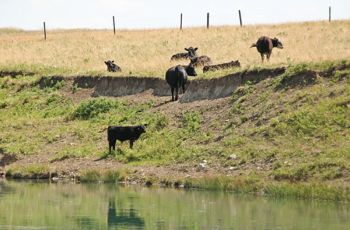Controlling Animal Activity: Difference between revisions
No edit summary |
|||
| (13 intermediate revisions by 4 users not shown) | |||
| Line 1: | Line 1: | ||
__NOTOC__ | |||
[[Category:Operation and Maintenance]] | |||
---- | |||
{{Picture | |||
|image= | |||
<!-- Add image file name (ex.image.jpg) --> | |||
animalactivity.jpg | |||
|link= | |||
https://damfailures.org/lessons-learned/embankment-dams-and-levees-are-vulnerable-to-damage-from-wildlife-intrusions-and-animal-impacts/ | |||
|caption= | |||
<!-- Add picture caption --> | |||
Livestock can damage embankment dams by grazing, stomping out, or otherwise destroying vegetation, thus increasing the likelihood of accelerated soil erosion. (Image Source: [https://damfailures.org/lessons-learned/embankment-dams-and-levees-are-vulnerable-to-damage-from-wildlife-intrusions-and-animal-impacts/ DamFailures.org]) | |||
}} | |||
“Often constructed outside of developed areas, the earthen dam [[environment]] is usually near a water source and can contain a variety of vegetation; given these characteristics, earthen dam environments can be naturally conducive to use by wildlife. Wildlife inhabiting the dam can alter the dam environment through habitat establishment and use – beaver build dams, muskrat excavate dens, livestock feed on stabilizing vegetation. The natural instincts of wildlife to adapt and use their environment toward their survival can compromise the balance of engineered functions that maintain the viability of an earthen dam”.<ref name="FEMA P-473">[[Technical Manual for Dam Owners: Impacts of Animals on Earthen Dams (FEMA P-473) | Technical Manual for Dam Owners: Impacts of Animals on Earthen Dam (FEMA P-473), FEMA, 2005]]</ref> | |||
==Examples== | |||
{{Website Icon}} [https://damfailures.org/case-study/santa-clara-dam-utah-2012/ Learn more about the dangers of rodent burrows in embankment dams from the failure of Santa Clara Dam (DamFailures.org)] | |||
{{Website Icon}} [https://damfailures.org/lessons-learned/embankment-dams-and-levees-are-vulnerable-to-damage-from-wildlife-intrusions-and-animal-impacts/ Learn more about the many ways animals can negatively impact a dam at DamFailures.org] | |||
<noautolinks>==Best Practices Resources==</noautolinks> | |||
{{Document Icon}} [[Technical Manual for Dam Owners: Impacts of Animals on Earthen Dams (FEMA P-473) | Technical Manual for Dam Owners: Impacts of Animals on Earthen Dams (FEMA P-473), FEMA]] | |||
==Trainings== | |||
{{Video Icon}} [[On-Demand Webinar: Understanding and Managing Plant & Animal Intrusions in Embankment Dams and Levees]] | |||
{{Video Icon}} [[On-Demand Webinar: Understanding and Managing Plant and Animal Intrusions in Embankment Dams and Levees – II]] | |||
</br> | |||
{{Citations}} | |||
<!-- Revision history information --> | |||
{{revhistinf}} | {{revhistinf}} | ||
Latest revision as of 20:14, 18 July 2023

|
| Livestock can damage embankment dams by grazing, stomping out, or otherwise destroying vegetation, thus increasing the likelihood of accelerated soil erosion. (Image Source: DamFailures.org) |
“Often constructed outside of developed areas, the earthen dam environment is usually near a water source and can contain a variety of vegetation; given these characteristics, earthen dam environments can be naturally conducive to use by wildlife. Wildlife inhabiting the dam can alter the dam environment through habitat establishment and use – beaver build dams, muskrat excavate dens, livestock feed on stabilizing vegetation. The natural instincts of wildlife to adapt and use their environment toward their survival can compromise the balance of engineered functions that maintain the viability of an earthen dam”.[1]
Examples
![]() Learn more about the many ways animals can negatively impact a dam at DamFailures.org
Learn more about the many ways animals can negatively impact a dam at DamFailures.org
Best Practices Resources
![]() Technical Manual for Dam Owners: Impacts of Animals on Earthen Dams (FEMA P-473), FEMA
Technical Manual for Dam Owners: Impacts of Animals on Earthen Dams (FEMA P-473), FEMA
Trainings
Citations:
Revision ID: 7292
Revision Date: 07/18/2023
